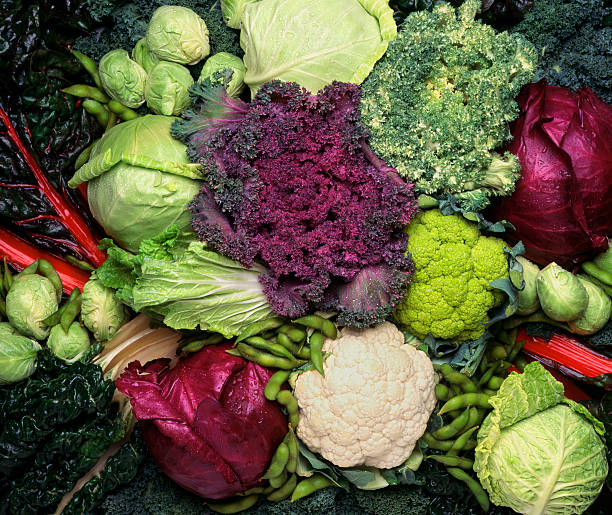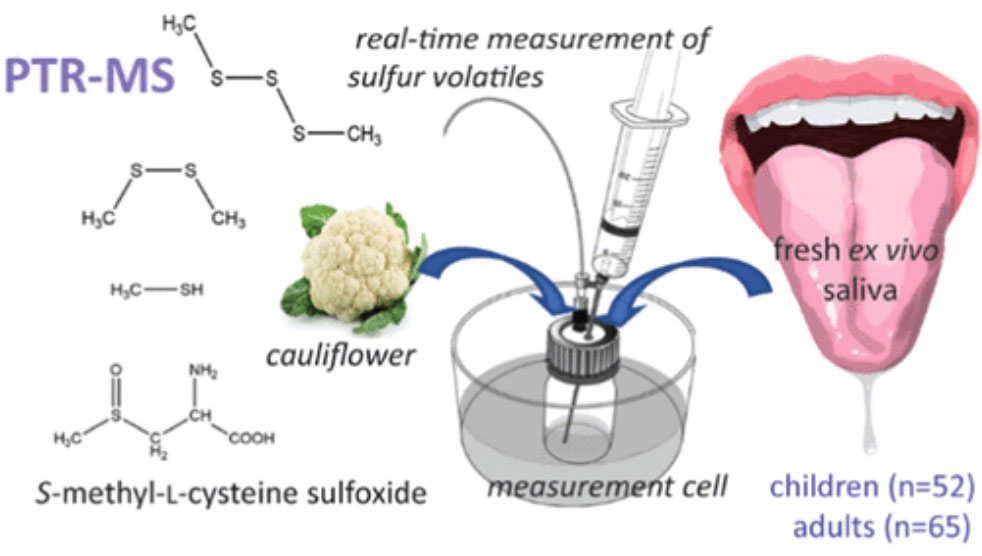| |
Highlights
Vegetable consumption is critical to lead a healthy lifestyle and prevent chronic disease, but many people, especially children, don’t like vegetables. Brassica vegetables, including broccoli, cabbage, and Brussels sprouts, are some of the most disliked vegetables. These researchers studied Brassica consumption in 98 parent-child pairs. They found Brassica vegetables are disliked not only for their bitterness but also for the sulfur compounds they release when mixed with saliva. Children whose saliva produced more sulfur compounds when mixed with cauliflower powder disliked cauliflower the most, but this was not true of adults. This suggests that we can learn to eat and like vegetables over time.
How many servings of vegetables do you eat per day? Which are your favorite kinds of vegetables to eat? If you’re not a big fan of vegetables, or if you don’t eat them very often, you are not alone. Many children (and adults) struggle with eating their vegetables. One of the most disliked family of vegetables is the
Brassica
family, which includes broccoli, cauliflower, and cabbage. New research by Dr. Damian Frank and colleagues at the Commonwealth Science and Industrial Research Organisation (CSIRO), Australia’s national science agency, reveals one reason why many children (and some adults) find Brassica vegetables so distasteful: the products of the chemical reactions they produce in our mouths.

Figure 1. Common Brassica vegetables
[Source: https://www.istockphoto.com/photos/cruciferous-vegetables]
Vegetables are so important for our health because they are an abundant source of nutrients and minerals that help keep our bodies strong. According to the United States Department of Agriculture, research shows that consumption of fruits and vegetables as part of a healthy diet can have long-lasting health impacts and reduce chronic conditions such as
heart disease,
cancer,
and
diabetes,
among others. This is why vegetable consumption is an important public health issue.
In order to increase vegetable consumption amongst Australian children, scientists at CSIRO developed educational materials for children, their parents, and teachers to learn about the importance of vegetables. In addition, team members including Dr. Damian Frank conducted research to better understand the barriers to vegetable consumption for children and adults. A chemist by training, Dr. Frank specializes in sensory food science and contributed to the Sensory, Flavor, and Consumer Science group at CSIRO for many years.
Dr. Frank and his team focused on the Brassica vegetable family because they are often more disliked than other vegetables that may be sweeter or more flavorful. Brassica vegetables include broccoli, cauliflower, cabbage, brussels sprouts, kale, collard greens, and turnips. When the plant tissue of these vegetables breaks down, it releases compounds such as isothiocyanates (ITCs) that produce the bitter taste in our mouths. Most research into Brassica vegetables has focused on their bitterness.
In addition, Dr. Frank and his team focused on another compound called S-methyl-L-cysteine sulfoxide (SMCSO). SMCSO makes up about one percent of the dry weight of Brassica vegetables, which is quite a lot for any given compound. When SMCSO comes in contact with certain bacteria in the saliva, such as Fusobacterium nucleatum, it can catalyze the production of sulfur compounds, which have a very unpleasant odor. Dr. Frank and his team hypothesized that the more of these bacteria a person has in their saliva, the less they would like Brassica vegetables.
As part of this research, Dr. Frank and his team invited children ages 6-8 years with their legal parent or guardian to come to the laboratory for a vegetable taste testing and to provide saliva samples. All participants had to be in good overall health and have previously eaten broccoli or cauliflower without an allergic reaction. Anyone who had an impaired sense of smell, for example due to illness or medication, was not allowed to participate. In total, 98 parent-child pairs (196 people total) participated in the study.
Before bringing participants into the laboratory, Dr. Frank and his team identified the strongest odor-producing compounds in broccoli and cauliflower to test during the experiments. To do this, the researchers used a technique called gas chromatography-olfactometry-mass spectrometry. This method allows for the separation of aromas into their component parts that can be tested separately and is often used in food science research.

Figure 2. Gas chromatography olfactometry
[Source: https://odourobservatory.org/measuring-odour/gas-chromatography-olfactometry/]
Once the compounds had been separated, the team used trained sniffers to determine the strongest of the compounds. These experiments showed the top five odor-impact compounds in broccoli and cauliflower are:
- Dimethyl trisulfide (DMTS) – a rotten, sulfurous odor often found in the Brassica family
- 4-isothiocyanate-1-butene (4-ITC-butene) – earthy odor, like in radishes
- (Z)-3-hexen-1-ol – the odor of freshly chopped green leaves
- Allyl isothiocyanate (allyl-ITC) – the odor of stale broccoli
- β-ionone – floral odor found only in raw broccoli
In the laboratory, parent-child pairs were asked to complete several tasks. First, they were asked to provide a saliva sample. This sample was mixed with cauliflower powder and the researchers measured the amount of sulfur production in the mixture.

Figure 3. Measurement of sulfur volatiles produced by mixing cauliflower powder with fresh saliva from children and adults
[Source: Frank et al. 2021]
Second, they were asked to rate their liking of a variety of vegetables, including Brassica vegetables and other vegetables more tolerated by children, such as carrots and sweet potatoes. For adults, this meant rating each compound on a nine-point liking scale such as the one shown below:

Figure 4. Typical nine-point liking scale used for adults
[Source: Dr. Frank]
The child participants also used a nine-point scale that was graphically represented using faces ranging from very sad to very happy like the one below:

Figure 5. Liking scale for children using faces. The spaces between the faces can also be used to create a nine-point scale.
[Source: Dr. Frank]
Third, the participants were exposed to each of the five aromatic compounds listed above and asked to rate them for liking and intensity using the nine-point scales. In addition, parents and children used these scales to evaluate a sample of raw cauliflower. Parent-child pairs conducted their evaluations separately with trained research assistants.
There were several important findings from this research:
- As expected, most participants reported they liked Brassica vegetables less than other kinds of vegetables.
- DMTS, a sulfurous odor, was the least liked by both children and their parents.
- Children whose saliva produced the most sulfur compounds when mixed with cauliflower powder also reported liking Brassica vegetables the least.
This last finding aligns with Dr. Frank’s hypothesis that it is not only the bitterness of Brassica vegetables that people find disagreeable. The production of sulfur when these vegetables are mixed with saliva seems to be another reason that some people may not like them.
There are two interesting points about this last finding. First, child-parent pairs had similar amounts of sulfur production in their saliva. This aligns with other research suggesting that parents and children have similar kinds of microorganisms inhabiting their mouths. Second, while it was true that increased production of sulfur compounds in saliva correlated with decreased liking of Brassica vegetables in children, this was not true for adults. Some adults who had very high levels of sulfur production reported they liked Brassica vegetables. “This seems to suggest that liking vegetables is something we can learn how to do,” commented Dr. Frank. “For example, most children don’t like the taste of coffee or dark chocolate, but many people come to like these tastes as they grow older.”
These findings offer new understanding into why many children might dislike vegetables, and Brassica vegetables in particular. Brassica vegetables are not only bitter and produce sulfur compounds, but children’s mouths are also smaller than adult mouths, meaning that these sensations might be more intense. However, over time, both children and adults can learn to enjoy their vegetables.
Dr. Frank suggests that we should have more compassion for those who dislike vegetables. Many vegetables are an acquired taste that take time to get used to. In the meantime, though, it is still critically important to eat your vegetables. If you don’t like the taste, vegetables can be combined with other flavors, mixed into stews, smoothies, and other dishes, to make the flavor less intense.
Dr. Damian Frank is currently a Research Scientist at All G Foods in Australia, a new company developing plant-based meat and dairy products. Previously, Dr. Frank worked in the Sensory, Flavor, and Consumer Science group at CSIRO. Dr. Frank’s work focuses on food science and flavor chemistry. When not in the laboratory, Dr. Frank enjoys cooking, traveling, learning new languages, and spending time outdoors.
For More Information:
- Frank, D. et al. 2021. “In-Mouth Volatile Production from Brassica Vegetables (Cauliflower) and Associations with Liking in an Adult/Child Cohort.” Journal of Agriculture and Food Chemistry, 69: 11646-54. https://pubs.acs.org/doi/10.1021/acs.jafc.1c03889
- American Chemical Society. "Children’s dislike of cauliflower, broccoli could be written in their microbiome." ScienceDaily. ScienceDaily, 22 September 2021. https://www.sciencedaily.com/releases/2021/09/210922090903.htm
To Learn More:
- My Plate, USDA: https://www.myplate.gov/eat-healthy/vegetables
- USDA: Fruit and vegetable information. https://www.nal.usda.gov/legacy/fnic
- American Heart Association. https://www.heart.org/en/healthy-living/healthy-eating/add-color/how-to-eat-more-fruits-and-vegetables
Written by Rebecca Kranz with Andrea Gwosdow, PhD at www.gwosdow.com
HOME | ABOUT | ARCHIVES | TEACHERS | LINKS | CONTACT
All content on this site is © Massachusetts
Society for Medical Research or others. Please read our copyright
statement — it is important. |
|
|

Dr. Damian Frank
Sign Up for our Monthly Announcement!
...or  subscribe to all of our stories! subscribe to all of our stories!

What A Year! is a project of the Massachusetts
Society for Medical Research.
|
|

